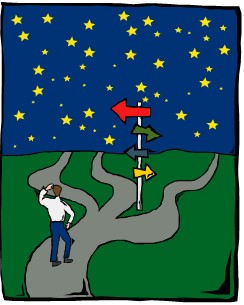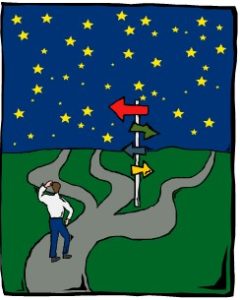
Start From the Beginning
Once you’ve defined a destination, now what? Where do you start? There’s only one place to start. You have to start where you are.
This may seem obvious but you’d be amazed how often we pretend we’re closer to our destination because we think we should be closer. Or maybe we don’t want to think of how far we have to go. Or maybe we think it will somehow make our path easier. This isn’t very effective. Imagine trying to go from New York to Chicago, but pretending you were in Columbus Ohio.
Everything’s Relative
In simplistic terms, this again relates to Albert Einstein’s theories of relativity – everything must be defined relative to, or with respect to, something else. It doesn’t matter whether you define the start or the end first. If you define the relativeness of the start and end points, you’ve then defined a distance. You’ve also defined a direction.
First let’s clarify some terms. A destination or endpoint is a point in space that you want to move to. A vision is a detailed description of a point in space. A goal implies using your energy and taking action with the intention of moving from one point in space to another. This is true whether it’s a physical space or a metaphysical space.
Imagine your destination with respect to where you are today. Think of it in physical terms, by imagining it as a certain physical distance away, and moving towards it by taking physical steps. If you were to place it at a relative distance from you, how far would it be? You have a sense of the relative distance away from your current position. Would it be in the same room? the same street? the same city? the same continent?
Now get a sense of how you feel about using your energy to reach that destination. Is it motivating and inspiring, or is it overwhelming? If your vision of this destination seems too big, if the distance seems too far away, you can get discouraged from even starting. It seems like too much effort.
If It Feels Like a Marathon
Imagine you’ve decided to run a marathon. You’ve set a goal to move towards that “destination.” If you’re someone who has been running shorter distances on a consistent basis, then setting that goal would not seem so daunting. If you’re someone who hasn’t run further than the distance to your mailbox for many years, just thinking about the marathon may make you feel out of breath. Will you be able to go the distance?
World peace and global health are destinations that we would like to get to. Sometimes it feels like it would take a thousand marathons to get there and it discourages us from even trying. But never fear, physics is here….
Distances are additive. And distances are distinct from time.
Virtually anyone who is reading this has covered the distance of several marathons in their lifetime. All that is required is taking steps. If the destination is close, the number of required steps is fewer. If it is far, you need to take more steps.
Focusing on a checkpoint is not giving up on your dream. It is the first step towards your final destination. If we take steps towards our intended destination, eventually we’ll get there.
It’s important to make the distinction between distance and time because we tend to focus on wh ether we have enough time instead of whether we can go the distance. If we only focus on the steps, we may find the time is much shorter than we had expected.
ether we have enough time instead of whether we can go the distance. If we only focus on the steps, we may find the time is much shorter than we had expected.
A prevailing concern is that we’re running out of time to stop climate change. That isn’t a productive focus. Time may limit the number of possible paths to take, but what’s important is to cover the distance, to do all the necessary things to get there. Einstein defined the maximum speed of anything as the speed of light. That’s fast. Focus on the destination.
Get Into Motion
The most important factor is to get into motion. The distance may be very short to reach your destination, but no matter how close it is, if you don’t move towards it, it won’t get accomplished. Our rate of motion, or speed, is the change in distance per the amount of time. The faster we cover the distance, the quicker we will arrive at our destination.
In every case, by defining two out of the three components of distance, time and speed, the third component becomes clear.
We can only change the distance – by changing the location of our destination or the route we take, change the time, or change the speed. That’s all.
If you want to make a million dollars in your first year of operations, you need to get moving. If you decide you don’t want to do what it takes to move at that speed, you might change the time to making a million dollars in the first five years. Or ten years. Or you can decide how quickly you will move, keep the time the same, and change the distance to making $100,000 in the first year.
Speeding Up
For some people, the idea of speeding up is not very appealing. These people say, “Life is moving too fast. I can’t keep up!” I ask them if they feel like they are going too fast when they are riding in an airplane, or when they are driving the speed limit on the expressway. They don’t normally see that as a problem. I tell them that just as speed does not seem to be a problem then, speed doesn’t need to be a problem in our lives. If we feel in control, if we have the right vehicle to carry us along, we can be comfortable at higher speeds.
While some of this perception of speed comes from the fact that we now have tools that enable us to complete tasks more quickly and efficiently, another factor has to do with the intervals between steps.
Within the last 100 years in the U.S., communications were delivered on horseback by Pony Express. The automobile then increased the speed of delivery. With the advent of telecommunications, our ability to transmit information took a huge leap, allowing us to deliver verbal messages to one destination via telephone, moving quickly into the ability to deliver auditory and visual forms of information by television and radio to many people at once, as well as providing lengthy hardcopy documents by fax. Now, we can not only deliver one document to one person with a push of a button, but we can use the Internet to communicate lengthy hardcopy information to a multitude of people, as well as broadcasting live television and radio programs around the world. And now with cell phones, We can call or text someone anytime and anywhere.
Taking Breaks
We don’t have to wait as long between steps anymore. This doesn’t necessarily mean we are doing our own tasks any faster; it means that we don’t have as long a break between tasks, and this increases the overall perception of speed in our lives.
The good thing about this is that we can accomplish more in a lifetime. The down side of it is that we may not feel like we ever get a rest! As we will see when we study Stress, we must consciously put in the breaks.
My husband is a marathoner. At one point he was following a training program that involved running for a mile, then walking for a minute, then running for a mile, then walking for a minute. It was a good practice to get him used to the long distances.
The most important thing is to get into motion to cover the distance. That might be physical motion, and it might be metaphysical motion. And you might be amazed how quickly you can arrive at that destination.
